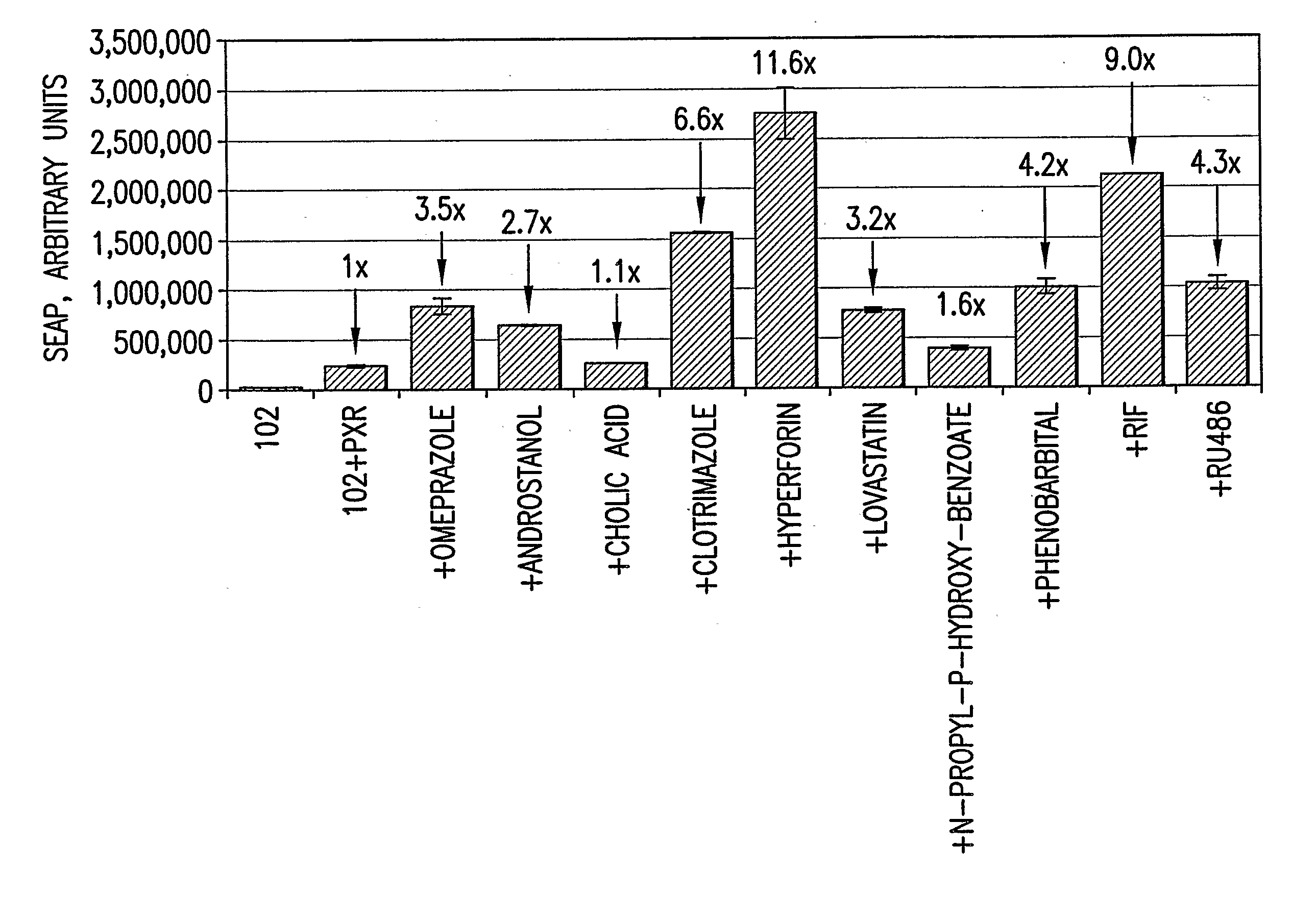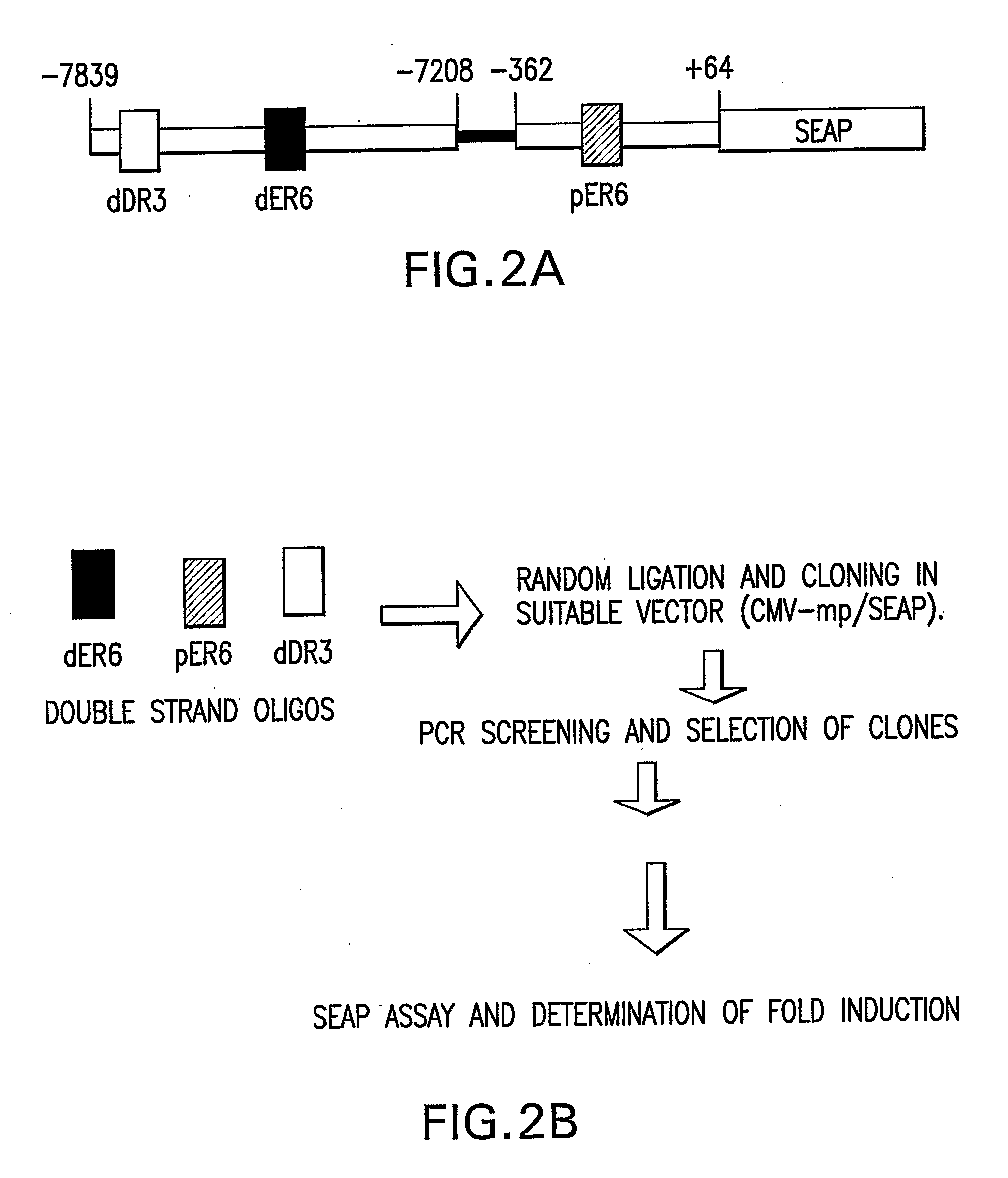Cytochrome P450 Induction Assay
a cytochrome p450 and induction assay technology, applied in the field of cytochrome p450 induction assay, can solve the problems of reduced therapeutic efficacy, induction may create an undesirable imbalance between toxification and detoxification, and the availability of human hepatocytes is often very limited
- Summary
- Abstract
- Description
- Claims
- Application Information
AI Technical Summary
Benefits of technology
Problems solved by technology
Method used
Image
Examples
example 1
[0119] To determine whether a PXR-responsive promoter that was stronger than that in the prior art could be constructed, the nucleotide sequence of the responsive cis-acting nucleotide elements of the CYP3A4 promoter were chemically synthesized into short oligomers, which were then randomly assembled into composite promoters to produce recombinant libraries consisting of a plurality of composite promoter configurations, which were then screened for transcriptional activity. The strategy is shown in FIG. 2B. A similar strategy had been used by Li et al. Nature Biotech. 17: 241-245 (1999) to generate a composite muscle specific promoter that was stronger than the naturally occurring myogenic promoters.
[0120] The nucleic acid manipulations were performed in accordance with standard molecular biology methods such as those described in Sambrook et al., Molecular Cloning: A Laboratory Manual 2nd Edition; Cold Spring Harbor Laboratory Press, Cold Spring Harbor, N.Y., (1989) or Sambrook an...
example 2
[0127] Each of the cloned DNAs isolated from the colonies of the library in Example 1 was separately co-transfected with plasmid DNA encoding the human PXR into HepG2 cells as shown below to produce transiently transfected HepG2 cells, each expressing SEAP operably linked to one of the composite promoters. Expression of SEAP was measured in the presence and absence of 10 μM Rifampicin as an inducer of PXR activation of SEAP transcription.
[0128] The human hepatoma cell line, HepG2, was grown in high glucose Dulbecco's modified Eagle medium (DMEM; Life Technologies, Bethesda, Md.) supplemented with 2 mM L-glutamine, 100 U / mL of Penicillin, 100°g / mL streptomycin, and 10% fetal bovine serum. Cells were sub-cultivated twice a week with a 1:5 split ratio. For the assay, the HepG2 cells were split and seeded into the wells of six-well tissue culture plates. The next day after seeding, the plated cells were transfected with a mixture of DNA consisting of 0.9 μg of library reporter plasmid ...
example 3
[0139] HepG2 cells transfected with clone 102-SEAP DNA were evaluated for ability to identify CYP3A4 inducers.
[0140] The human hepatoma cell line, HepG2, grown as in Example 2 were split and seeded into the wells of six-well tissue culture plates. The next day after seeding, the plated cells were transfected with a mixture of DNA consisting of 0.9 μg of clone 102-SEAP DNA or ΔCYP3A4 / SEAP DNA and 0.1 μg pSG5 dATG-hPXR DNA in Lipofectamine and PLUS Reagent. Control assays consisted of 0.9 μg of clone 102-SEAP DNA and not the NR donor plasmid.
[0141] Three hours post-transfection, the medium for each well was replaced with fresh DMEM-GM containing either 200 μM Omeprazole, 10 μM Androstanol, 100 μM Cholic Acid, 6 μM Clotrimazole, 125 nM Hyperforin, 12.5 μM Lovastatin, 100 μM N-propyl-p-hydroxy-benzoate, 1 mM Phenobarbital, 10 μM Rifampicin, or 10 μM RU486. After incubating the cells 48 hours at 37° C., the medium form wells were collected for SEAP assays. The assays for SEAP expressio...
PUM
| Property | Measurement | Unit |
|---|---|---|
| total volume | aaaaa | aaaaa |
| lipophilic | aaaaa | aaaaa |
| Electrophoretic Mobility Shift Assays | aaaaa | aaaaa |
Abstract
Description
Claims
Application Information
 Login to View More
Login to View More - R&D
- Intellectual Property
- Life Sciences
- Materials
- Tech Scout
- Unparalleled Data Quality
- Higher Quality Content
- 60% Fewer Hallucinations
Browse by: Latest US Patents, China's latest patents, Technical Efficacy Thesaurus, Application Domain, Technology Topic, Popular Technical Reports.
© 2025 PatSnap. All rights reserved.Legal|Privacy policy|Modern Slavery Act Transparency Statement|Sitemap|About US| Contact US: help@patsnap.com



